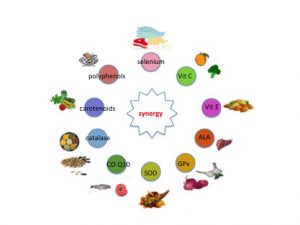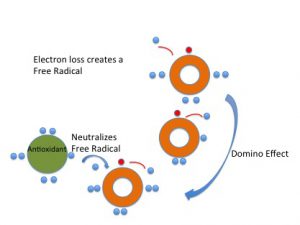Antioxidants – the elixir of youth?
Understanding antioxidants and what it does in your body. This is Part 1 of a two-part article.
BY:  Mayura Mohta
Mayura Mohta
Antioxidants are our guardian angels that protect us from disease and degeneration. Most of us perceive antioxidants as the first line of defence against ageing and the resulting infirmities commonly called oxidative damage. Media-hype and the supplement industry tout them as magic pills to be had regularly for optimal health.
However, the effect of antioxidants on our body is complex and they tend to have a Jekyll-and-Hyde personality. Some studies talk about the benefits whereas other studies point to the damage they can cause. Before we arrive at any conclusion, let’s first understand what are antioxidants:
What is an antioxidant?
Antioxidants are free radical quenchers. To understand antioxidants and their effect on the body is it important to understand free radicals and oxidation.
Free radicals are highly charged and unstable molecules (having a single electron), which destabilise other molecules by attaching to them – a process commonly referred to as oxidation.
 What is oxidation and how does it work?
What is oxidation and how does it work?
Oxygen is the basis of all plant and animal life. All body processes make use of oxygen to generate energy. However, oxygen is chemically reactive and easily becomes unstable, acquires a negative charge and thus “oxidises “other molecules. Unless controlled, this can lead to a domino effect whereby many free radical reactions are spawned, leading to cellular damage that triggers inflammation, cancer and ageing. Free radicals are generated through normal metabolic processes and immune reaction where the free radicals destroy the pathogen. External factors such as pollution, radiation, pesticides, smoking and trauma also results in oxidative damage due to creation of free radicals.
Free radicals are dangerous if in excess but not always a bad thing.
So how do we control these “hyper” molecules?
 A large degree of control is achieved by consuming a diet high in special nutrients called antioxidants. These self-sacrificing nutrients donate an electron and neutralise the charged free radical, thereby preventing cellular damage. Some anti-nutrients can even stop the formation of free radicals. The more antioxidants you consume, the lesser will be the free radical content in the body and oxidative damage is hence controlled. Antioxidant protection confers good health in the long run.
A large degree of control is achieved by consuming a diet high in special nutrients called antioxidants. These self-sacrificing nutrients donate an electron and neutralise the charged free radical, thereby preventing cellular damage. Some anti-nutrients can even stop the formation of free radicals. The more antioxidants you consume, the lesser will be the free radical content in the body and oxidative damage is hence controlled. Antioxidant protection confers good health in the long run.
Epidemiological studies reveal the low incidence of specific diseases such as heart disease, cancer, osteoporosis, etc, in certain countries is directly related to specific antioxidant-rich nutrients in the regional diet. Some examples are as follows:
- Tomatoes – Contain lycopene, an antioxidant that prevents DNA from toxic damage.
- Citrus fruits like grapefruit and oranges – Contain limonene, which boosts enzymes that eliminate carcinogens.
- Green tea – Contain polyphenols that aid the liver in the elimination of toxins.
- Garlic, onions and leeks – Contain allyl sulfides, which help regulate liver enzymes and increase excretion of carcinogens.
- Cruciferous vegetables (broccoli, cabbage, cauliflower, etc) – Contain sulforane, that stimulates liver enzymes to excrete toxic residues.
- Soybeans – Contain isoflavones, which are antioxidants and phytoestrogens that are anti-cancer.
- Grapes and berries (strawberries, raspberries, boysenberries, etc) – Contain anthocyanidins (flavenoids), which help to stabilise the walls of our blood vessels.
High concentration of antioxidants occurs in all coloured fruits and vegetables, especially wheat and barley grass, sprouts and dark green vegetables. People who are constantly exposed to toxins from the environment or those with weakened immunities should consume such foods regularly. Such people should avoid any processed foods as heat processing oxidises most nutrients making them rancid and harmful.
How do we protect our Qi and how does this apply to antioxidants?
Qi is the body’s protective “yang” energy that protects us from bacteria, viruses and germs. This energy is diminished by consumption of highly processed foods (low in antioxidants). The “yang” protective energy is regained by eating unprocessed foods (high in antioxidants) such as whole grains, seasonal fruits, vegetables, spices and herbs.
Overwork or lethargy also reduces qi. Too much physical and mental stress generates free radicals. A balance of work and wise eating habits would be most suitable for optimum health.
What are the different types of antioxidants?
Antioxidants can be classified into two groups: Endogenous (made in the body) and exogenous (from diet or supplements). The former are far more potent than the latter. Antioxidants are either water-soluble or fat-soluble.
|
EXOGENOUS ANTIOXIDANTS: |
FOOD SOURCES: |
|
Vitamin C |
Berries, citrus fruits and avocados |
|
Vitamin E |
Nuts, seeds, whole grains and eggs |
|
Carotenoids |
Carrots, spinach, papaya and tomatoes |
|
Selenium |
Fish, garlic and brown rice |
|
Polyphenols |
Olives, onions and green tea |
|
Superoxide Dismutase (SOD) |
Melons, cantaloupe, corn, soy and wheat |
|
Alpha Lipoic Acid (ALA) |
Liver and Brewer’s yeast (used to make beer) |
|
Co-enzyme Q10 |
Meat, fish, nuts and seeds |
|
Catalase |
Apples, grapes, mangoes and mushrooms |
|
Glutathione Peroxidase (GPx) |
Lentils, beans, white meat, nuts and seeds |
The body’s production of endogenous antioxidants declines with age leading to ageing and to the onset of chronic age-related diseases. Boosting cellular levels of antioxidants through diet and supplements could help control and prevent age-related diseases.
How do antioxidants work in the body?
The extent of protection offered by antioxidants depends on their interaction with each other and with other metabolites or enzymes. They work in a synergistic manner and their beneficial effects are directly related to the concentration and reactivity with the free radicals present.
The synergy of exogenous antioxidants such as vitamins C and E, and beta-carotene, as well as endogenous antioxidants such as glutathione, lipoic acid and coenzyme Q10 is vital for disarming oxidants properly.
The antioxidant potential of each food can be rated by checking the number of ORAC (oxygen radical absorbance capacity) units. Foods with high ORAC have better antioxidant potential.
What is the difference between a phytochemical and an antioxidant?
Phytochemicals or phytonutrients are chemicals that the plant produces to protect itself from adversity. These chemicals also give pigmentation to the plant and is life-sustaining substances for the plant and us. They can act as an antioxidant but perform other roles as well. Antioxidants, on the other hand, could be phytochemicals, vitamins or minerals. Popular examples of phytochemicals that serve as antioxidants are vitamins C and E, and beta-carotene.
Mayura Mohta is a biochemist and microbiologist, who founded social enterprise Healthfriend in 2010. The organization seeks to promote wise eating choices and healthy nutritional habits within the community for sustainable wellness and a better quality of life, It does this through nutrition workshops and seminars that bust common food myths. Profits generated are ploughed back into the local community, through various charities in Singapore and India that support malnourished and underprivileged children.
(** Pictures courtesy of the writer. The strawberry image is from stock.xchng from 885mech.)


0 Comments